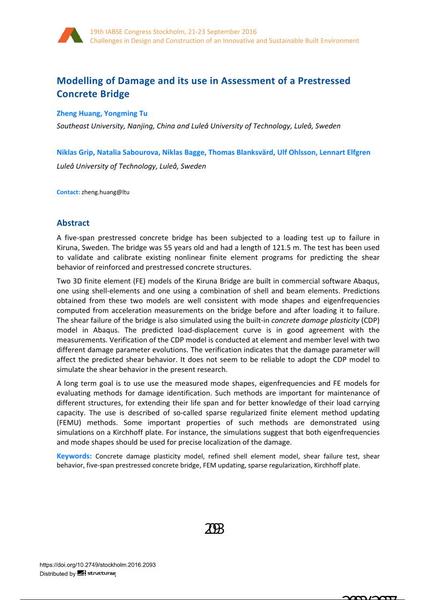Modelling of Damage and its use in Assessment of a Prestressed Concrete Bridge

|
|
|||||||||||
Détails bibliographiques
| Auteur(s): |
Zheng Huang
(Southeast University, Nanjing, China and Luleå University of Technology, Luleå, Sweden)
Yongming Tu (Southeast University, Nanjing, China and Luleå University of Technology, Luleå, Sweden) Niklas Grip (Luleå University of Technology, Luleå, Sweden) Natalia Sabourova (Luleå University of Technology, Luleå, Sweden) Niklas Bagge Thomas Blanksvärd (Luleå University of Technology, Luleå, Sweden) |
||||
|---|---|---|---|---|---|
| Médium: | papier de conférence | ||||
| Langue(s): | anglais | ||||
| Conférence: | IABSE Congress: Challenges in Design and Construction of an Innovative and Sustainable Built Environment, Stockholm, Sweden, 21-23 September 2016 | ||||
| Publié dans: | IABSE Congress Stockholm, 2016 | ||||
|
|||||
| Page(s): | 2093-2108 | ||||
| Nombre total de pages (du PDF): | 16 | ||||
| Année: | 2016 | ||||
| DOI: | 10.2749/stockholm.2016.2093 | ||||
| Abstrait: |
A five-span prestressed concrete bridge has been subjected to a loading test up to failure in Kiruna, Sweden. The bridge was 55 years old and had a length of 121.5 m. The test has been used to validate and calibrate existing nonlinear finite element programs for predicting the shear behavior of reinforced and prestressed concrete structures. Two 3D finite element (FE) models of the Kiruna Bridge are built in commercial software Abaqus, one using shell-elements and one using a combination of shell and beam elements. Predictions obtained from these two models are well consistent with mode shapes and eigenfrequencies computed from acceleration measurements on the bridge before and after loading it to failure. The shear failure of the bridge is also simulated using the built-inconcrete damage plasticity(CDP) model in Abaqus. The predicted load-displacement curve is in good agreement with the measurements. Verification of the CDP model is conducted at element and member level with two different damage parameter evolutions. The verification indicates that the damage parameter will affect the predicted shear behavior. It does not seem to be reliable to adopt the CDP model to simulate the shear behavior in the present research. A long term goal is to use use the measured mode shapes, eigenfrequencies and FE models for evaluating methods for damage identification. Such methods are important for maintenance of different structures, for extending their life span and for better knowledge of their load carrying capacity. The use is described of so-called sparse regularized finite element method updating (FEMU) methods. Some important properties of such methods are demonstrated using simulations on a Kirchhoff plate. For instance, the simulations suggest that both eigenfrequencies and mode shapes should be used for precise localization of the damage. |
||||
